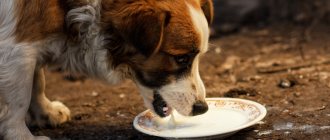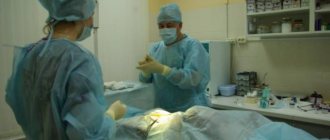Wounds can appear on a dog’s body for a variety of reasons, for example, as a result of contact with dry grass, branches of bushes and trees, and plant thorns. A piece of glass or other sharp objects can also damage the skin. Many animals are crushed under the wheels of vehicles, resulting in more serious consequences than scratches and small open wounds. To decide how to treat a dog’s wound, you need to examine it and assess the severity of the wounds received.
How to treat a dog's wound
If for one reason or another the animal is seriously injured (it is not possible to stop the bleeding on its own, large lacerations that must be sutured), then you should immediately seek help from a veterinarian in order to avoid dangerous consequences.
Types of wounds in dogs
Depending on the characteristics of the object causing the wound, wounds are classified into nine types.
Table 1. Types of wounds in dogs
| Type of wound | Description |
| Scratches with abrasions | They arise as a result of a dog touching an object or plant while trying to vigorously scratch a certain area of the body. Some animals injure themselves by biting fleas or trying to get rid of mats and pieces of matted fur. |
| Cuts | Appear on the pet's body upon contact with various objects with sharp edges. It happens, for example, that the tissues of the mouth are injured by the broken ends of chewed bones |
| Severe bites from other animals | Wounds of this nature are most often subject to inflammatory processes. This is due to the fact that from the very beginning the surface of the damaged area of the body is contaminated with substances released from the aggressor’s mouth |
| Splinters | These foreign particles usually get into the paw when the dog is running outside. However, sometimes they have to be removed even from the tissues of the cheeks or tongue, because these pets love to chew wooden pieces of furniture |
| Injuries resulting from an accident | According to experts, it is in these cases that animals receive the most complex injuries, which may even be incompatible with life. |
| Puncture wounds | Damage occurs due to contact with a sharp object that can quite easily pass through living tissue. Depending on the nature of the damaging product, wound channels can be smooth or rough |
| Chopped wounds | They are a type of injury characterized by serious destruction of fairly deep tissues, as well as damage to the walls of lymphatic and blood vessels, and lacerated nerves. In many animals, joints and other bone elements are crushed |
| Bruised wounds | They occur after the dog’s body is exposed to blunt objects. In this case, as a rule, multiplication and crushing of not only the epidermis, but also deeper muscles occurs. In addition, minor blood loss occurs |
| Lacerations | Applied with a pointed object. For pets, they are dangerous due to rupture of tendons and ligaments, as well as various infections entering the body. |
It happens that dogs receive combined wounds. Moreover, each injury is accompanied by the risk of infection. After all, dirt and dust, fluff and hair, rust and foreign bodies penetrate inside damaged skin along with foreign objects. Therefore, even a small wound must be treated with an antiseptic.
There are special antiseptics for dogs
It should be noted that you should treat yourself at home only those wounds that are superficial and do not pose the slightest danger to the life of your pet.
Veterinarian recommendations
When owners are faced with the question of how to treat wounds on dogs, the first thing that comes to mind is a solution of brilliant green or iodine. Yes, indeed, they can lubricate an injured surface. However, it is very important to remember that veterinarians under no circumstances recommend treating the wound itself. The fact is that these solutions are alcoholic, so they can cause burns and irritation. Naturally, this will cause severe pain to the animal. Therefore, iodine or brilliant green can only be used to treat the edges of the wound.
How do you treat superficial wounds in dogs?
If the animal has received a shallow injury that has not affected the tissue, then the owner can treat the wound on his own without seeking help from a specialist. This treatment procedure is carried out according to the following instructions:
- Using a cotton swab soaked in a physical solution or Chlorhexidine, wipe the affected area of skin from potential foreign objects (specks of dust, bacteria, dirt);
When wiping a wound with chlorhexidine, be careful to apply pressure so as not to cause pain to the animal.
- Using scissors or a safety razor, remove hair from around the wound channel;
- Hydrogen peroxide and simultaneous short-term pressure on the damaged blood vessel need to stop the bleeding;
- The edges of the wound are treated with an antiseptic;
- In addition, it is important to ensure that the pet does not lick the wound, because the surface of the tongue is quite rough and causes irritation to already injured tissues. There is also a risk of infection in a disinfected wound. To do this, cover the surface with a tight bandage. However, there is a more convenient option - using a special collar.
The collar will prevent the dog from scratching or licking the injured area of skin
Antiseptics for treating wounds
When a person discovers a wound on his pet, he may become confused and not immediately decide which antiseptic is best to use. Experienced veterinarians advise pet owners to have a first aid kit that always contains a sufficient amount of hydrogen peroxide. This solution has a hemostatic effect and does not cause burns to the injured area of the body.
Every dog owner should have hydrogen peroxide for emergency use.
Chlorhexidine is also often used to treat shallow wounds. It is not only convenient to apply, but also completely cleanses the area of various contaminants and prevents pathogenic microorganisms from entering the wound.
For the purpose of antibacterial protection, Miramistin is also recommended - a solution that gently interacts with living tissues and does not cause burns to the skin and mucous membranes. Thanks to it, you can prevent infection of the animal’s body with dangerous bacteria and viruses. Veterinarians use the medication to prevent purulent inflammation and activate regenerative processes.
Miramistin provides quick help to the animal without causing pain
One of the widely used drugs is Furacilin. Its advantage over many other antiseptics is the absence of a specific odor and such side effects as skin irritation. A solution prepared from tablets can also be used to wipe wounds where the purulent process has begun.
Zelenka and iodine have an aggressive effect on wounded areas and lead to burns
To treat superficial damage, despite the opinion of many people, it is not recommended to use brilliant green and iodine. Experts explain this by the fact that these solutions contain alcohol, which, if it comes into contact with living tissue, causes burns. In addition, the substances greatly dry the skin and cause irritation.
The growth of a wound with pus may be a sign of its healing
Wound healing process in dogs
Shallow wounds of dogs begin to heal after purulent exudate forms on their surface and tissue granulation occurs around the wound canal. In addition, when hair, dirt and foreign particles enter the deep layers of tissue, a process begins to occur in the pet’s body that promotes the formation of pus. Therefore, exudate is necessary to ensure a proteolytic effect aimed at removing purulent substances from the wound canal.
If the wound is simple and has not become infected, it usually takes one to two weeks to heal. Healing of surgical wounds also occurs by so-called primary intention.
Lacerations can cause serious damage to a dog’s health, so it is best to heal them under the supervision of a veterinarian
If an animal receives lacerations or injuries accompanied by crushing of living tissue, the healing process occurs very slowly, especially when infected. This phenomenon is due to the fact that the healing of the wound channel occurs by secondary intention. To avoid serious complications, you need to seek help from a veterinarian. He must perform an operation to excise the edges of the wound, due to which healing begins to proceed by primary intention, which occurs much faster.
In the absence of proper treatment or its delay, the wound becomes inflamed and begins to fester. Getting rid of this problem is much more difficult, in addition, blood poisoning can occur as a result.
Video - Treatment of wounds in dogs: veterinarian's guidelines
What to do when your dog is injured
If the dog is injured, it must be given first aid on the spot. This condition is met regardless of what further actions will be, in particular, whether further treatment of the pet will be carried out independently or with the participation of a veterinarian.
The first aid technique depends on the nature and severity of the wound, however, the general principles of the algorithm of actions in this case presuppose the observance of clear priorities, and they are common to both people and animals. The generally accepted sequence of emergency measures looks like this:
- Stop bleeding in any way possible.
- Disinfection is the protection of the affected area from germs and other pathogens.
- Anesthesia.
- Stabilizing the victim in a position where he can be safely moved.
- Transporting the patient to the hospital.
There are several methods to stop bleeding, from which you need to choose the most convenient and appropriate for the situation. For example, if a paw is injured, you need to lay the dog on its back, raise the wounded paw above the level of the heart, press a napkin to the bleeding area and hold it in this position until the bleeding stops or until the pet is taken to the clinic). If the open area of the wound is very large, you should try to bring the separated edges together before pressing the wound. For deep wounds, bleeding is stopped by tamponade - placing sterile material (in no case cotton wool) inside the gaping cavity. Another possible way to solve the problem is to apply a tight bandage or tourniquet. The latter option requires certain skills; in their absence, the animal must be taken to the nearest medical facility as quickly as possible to receive more qualified temporary assistance.
To prevent infection, be sure to apply a bandage to the open wound. If the damaged area is very dirty, and there are no disinfectants at hand, it is better to rinse the open area with plain water than to leave street dirt inside - this will in any case reduce the likelihood of purulent inflammation. For the same reason, if there is no clean bandage, you can put a plantain leaf on the affected area during camping conditions, and tie a scarf or scarf on top of it. If there are small objects (chips, splinters, etc.) in an open wound, they should be carefully removed using tweezers or a cotton pad for this purpose.
Important! Deep wounds should not be washed, smeared, covered with disinfectant powders, or tamponed. All that is permissible in such cases is a loose bandage, sterile if possible, and immediate transportation to a veterinary clinic.
A few words about pain relief. Experienced experts advise refraining from using analgesics yourself when providing first aid to a dog. Even if the animal is severely injured, it is better to take it to a medical facility as quickly as possible and require anesthesia there. There are several reasons for this recommendation:
- the absence of pain syndrome can create a misleading feeling in the dog regarding the bodily injuries it has received, and the animal will cause additional harm to itself with a careless movement;
- tablet forms of analgesics act for too long and, in addition, it is quite difficult to force an animal that is already in a state of stress to take them, while not every owner can inject a dog, even if a suitable drug in solution is at hand ;
- an incorrectly selected dosage of a medication or an error in choosing a drug (not all popular analgesics are suitable for dogs) is an additional risk.
Light bruises, abrasions, scratches, splinters, small wounds or cuts (2–3 cm long and no more than 1 cm deep), in addition to disinfection treatment, do not require additional treatment.
Exceptions are injuries received by a dog in a fight with a stray or wild animal. You should always assume that your pet could have been bitten by an animal infected with a dangerous infection, so a visit to the veterinarian in such situations is mandatory. The same applies to a spider, snake or poisonous insect bite.
What can be processed
It is best to treat wounds for disinfection with hydrogen peroxide, chlorhexidine or furatsilin. These drugs have not only an antiseptic, but also a hemostatic effect.
Veterinarians do not recommend using iodine and brilliant green, the most popular antiseptics in the post-Soviet space, because they dry out the skin very much, as a result, the edges of the wound do not meet well and heal more slowly.
Did you know? Nowhere except Russia and several other countries that were formerly part of the USSR is green paint used. As it turns out, the antiseptic properties of this dye have not been scientifically proven.
What has been said, however, applies only to those situations where the animal owner has the opportunity to make the best choice. If a dog is injured while traveling, any means at hand is suitable for quickly disinfecting the wound - alcohol, lotion, vodka, cologne, potassium permanganate, as well as iodine or brilliant green.
If a dog's muzzle suddenly begins to swell during a walk, this means that the animal could have been bitten by a wasp or other insect, and the pet is developing a local allergic reaction. In such a situation, you need to have on hand not antiseptics, but local preparations containing steroid hormones, for example, hydrocortisone cream. In the absence of such means for prompt assistance to the animal, you can apply cold or a paste prepared from water and baking soda to the bite site.
Video: General principles of treating a wound in a dog
Features of the treatment of lacerated and weeping wounds in dogs
After damage is caused, regardless of its severity, various pathogenic microorganisms immediately accumulate on the surface of the skin around the wound. If the injury is torn and affects the deep layers of tissue, then after a couple of days the dog experiences a progressive inflammatory process.
Weeping wound on a dog
An equally common cause that leads to inflammation is failure to follow the rules of asepsis or the use of inappropriate antiseptics when the integrity of the skin and soft tissues is damaged. In this case, exudate containing blood plasma and lymph, as well as leukocytes, lymphocytes and other products of the inflammatory process is released from the wound channel. This substance provides a favorable environment for the proliferation of pathogenic bacteria and microorganisms. As a result, the formation of a weeping injury is observed. The wound emits a specific smell. Many owners note apathy and depression in their pet.
Lacerated wound in a dog
Carrying out therapy in such a situation involves carefully removing all exudate and crusts formed on the surface of the damaged area. After this, it is necessary to treat the area with a disinfectant. If your dog experiences severe itching of the skin and pain, you should consult a veterinarian who will recommend the most appropriate analgesics and antihistamines. Usually, Tavegin or Suprastin is prescribed, the active ingredients of which slow down the synthesis of histamine-like substances, thereby reducing the amount of exudate accumulating inside the wound.
Erythromycin ointment also effectively acts on harmful microbes, healing the wound
To eliminate pathogenic microflora, it is necessary to cover the affected area with ointments that have an antibacterial effect. Effective are “Vishnevskaya ointment”, “Tetracycline ointment”, and “Levomikol”. In severe cases, the animal is additionally given broad-spectrum antibiotics.
In addition to ointments and antibiotics, special sprays that can be found in veterinary pharmacies promote wound healing. Below are some brands of such drugs.
Sprays for treating wounds in dogs
Sprays
If you ask the clinic how to treat wounds on dogs, many doctors recommend special sprays. These include:
- "Chemi-spray." Sold as a solution in a spray bottle. Composition: chlortetracycline hydrochloride and gentian violet (active ingredients) and auxiliary components. Has anti-inflammatory and antimicrobial effects. Works great against fungi of the genus Candida. When applied to the wound surface it does not irritate it. But the disadvantages include a pungent odor, so some owners treat the animal in the fresh air. Before applying the drug, it is important to remove crusts, pus and, if any, dirt from the wound. The course of treatment should not last more than 10 days. Apply the spray three times a day.
- "Vetericin". Ingredients: sodium hypochloride and chloride, hypochlorous acid, phosphates and electrolyzed water. This spray is a universal remedy. Therefore, if the owner does not know how to treat a wound after a tick on a dog, you can opt for this particular drug. It is used for any wounds without exception. Has a healing effect and antimicrobial. Used 3-4 times a day. It must be sprayed directly onto the wound if it is open, or under a bandage. The duration of the course is unlimited. This drug can be used until the wound is completely healed.
- "Aluminspray". The composition includes: the active component aluminum oxide and auxiliary glue BF-6, ethanol, pine rosin. Can be used for all types of wounds. Veterinarians recommend this drug when treating sutures. Has an antiseptic and enveloping effect. Apply to the damaged area of skin once a day. The duration of the course is no more than 10 days. Spraying must be carried out while holding the bottle at a distance of 15-20 cm.
Purulent processes and recommended antibiotics
Often purulent processes begin to develop in the wound canal, which are accompanied by the formation of exudate and the manifestation of characteristic symptoms:
- A sharp increase in body temperature;
- Apathy;
- Weakness;
- Lack of appetite.
Indifference to food and apathetic mood indicate a deterioration in the dog’s condition
To eliminate undesirable consequences, the veterinarian must select suitable antibacterial medications that will help quickly cope with inflammation and suppuration of the injury. Effective and widely used drugs are:
- Cephalosporins - Cephalen, Cephalex, and Cefotaxime;
- Penicillins - “Sinulox”, “Ampicillin” and “Amoxicillin”;
- Tetracyclines – “Doxycycline”.
Broad spectrum antibiotics can be found in every pharmacy at an affordable price
As a rule, the course of therapy lasts no longer than two weeks. It should be noted that it is forbidden to apply sutures to wounds complicated by infectious microflora
What to do with open and deep wounds?
If your pet has received a deep wound, then, first of all, the surface must be washed and disinfected. Then antiseptic solutions are applied to the skin: Miramistin, Formalin or Chlorhexidine. However, you should not engage in further treatment on your own; it is better to consult a specialist to avoid any dangerous complications.
Self-medicating wounds in dogs is dangerous, since there is a high risk of germs entering and wound suppuration.
What to do if the wound does not heal
If the wound does not heal for a long time, you should understand the reasons for this process. A similar feature occurs in older animals and bitches after childbirth, since their immunity is weakened. To speed up regeneration, it is necessary to increase the number of treatments, as well as include wound-healing drugs in the form of ointments, for example, Panthenol or Levosin, in the treatment.
Often, tissue damage does not heal if the dog constantly licks or scratches it. To avoid this, be sure to wear a collar and cover it with a bandage. Limit active games and walks outside as much as possible. If there are no results for more than a month, suppuration appears, contact a veterinarian.
Features of a dog's diet after injury
After receiving an injury, which leads to destruction of the integrity of the skin, soft tissues, bones, nerves, tendons, blood and lymphatic vessels, processes begin to occur in the animal’s body aimed at stopping inflammation and regenerating the damage. Therefore, the dog quickly loses strength.
To avoid dehydration due to blood loss, the dog must have constant access to water.
To restore them and support the immune system, it is very important to provide your pet with adequate nutrition, along with which his body will receive all the necessary vitamins and beneficial microelements. In addition, it is necessary that he has constant access to clean water, because the injury is accompanied by blood loss, which requires restoration of the water balance.











